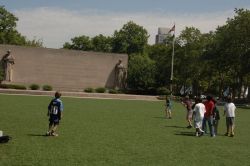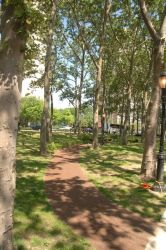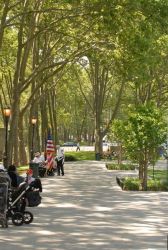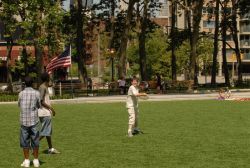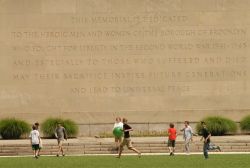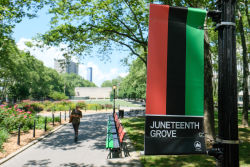Cadman Plaza Park
The Daily Plant : Tuesday, August 8, 2006
Now Voyager: Citywide Monuments Conservation Program Conserves Columbus Sculpture In Brooklyn

Photo by Kenny Wu
With major support from the History Channel, the Samuel H. Kress Foundation and the Italian Historical Society of America, for the past month, Parks’ Citywide Monuments Conservation Program staff and interns have been conserving the monument to Christopher Columbus at Cadman Plaza in Brooklyn. The monument’s journey has been almost as circuitous as that of the legendary Italian navigator and explorer himself.
Created by Emma Stebbins (1815-1882), this sculpture of Columbus was presented on February 20, 1869 by merchant and art patron Marshall O. Roberts to the Board of Commissioners of Central Park. The statue was described at that time as representing the seaman “standing upon the deck of a ship alone…before the West Continent burst into view,” ship’s tiller in hand, as his “mutinous crew have all deserted him.”
Stebbins was one of a group of women American expatriate sculptors living in Rome during the mid-19th Century whom author Nathaniel Hawthorne dubbed “the white marmorean flock” in his fictionalized account The Marble Faun. The sister of Park Board President Henry Stebbins, she is best known for creating the bronze statue of the Angel of the Waters, which serves as the central image of Central Park’s Bethesda Fountain.
Scrapbooks in the Archives of American Art indicate that the Columbus sculpture may have been carved as early as 1861, and that it was displayed for several years indoors at the McGowns Pass Tavern, a roadside house of hospitality located in Central Park’s northern precinct along the route of the old Albany Post Road. When the sculpture was bequeathed to the Park Board it was displayed in a protective “glass house” at the National Academy of Design, and its donor expressed a belief that it could be adequately waterproofed to make it suitable for an exterior setting.
There is no evidence that the work was ever installed outdoors in Central Park, and a short-lived sculpture court (at what is today’s Conservatory Garden) that may have been its intended home, was subsumed by the creation of the Metropolitan Museum of Art. In 1934 the statue was “discovered” stored in a packing crate at the 97th Street maintenance yard in Central Park. Parks’ Chief Consulting Architect Aymar Embury II (1880-1966) designed a new stylized limestone pedestal consisting of a fluted column with maritime-inspired cables on an octagonal base, and the statue was installed that year in Columbus Park (formerly Mulberry Bend Park) in Chinatown.
In 1971, following the renaming for Columbus of the southern part of Cadman Plaza in Brooklyn, the statue was moved again to its current placement in front of the New York State Supreme Court Building. The Park’s renaming and sculpture’s new placement was carried out through the efforts of John LaCorte, founder of the Italian Historical Society of America.
The conservation to be completed this week follows stone testing and analysis conducted by Monuments Program staff over the previous three summers. Though the monument was found to be structurally sound, it exhibited general surface erosion from acid rain, soiling, biological growth, failed masonry mortar joints, as well as damage and spalling of selected areas of the limestone pedestal.
The crew built an armature of nozzles that, through successive gentle mist-cleanings, removed surface soiling and algae build-up without harming the fragile stone surface. Several difficult areas of heavy soiling and gypsum crusts were treated using the Jos Rotec System, a high precision micro-abrasive cleaning technology developed specifically for the restoration of sensitive architectural and sculptural details. Following its cleaning, the sculpture has been treated with an anti-microbial product formulated for conservation, and an ethyl silicate consolidant is sprayed on to help bond the stone’s granular structure, limit moisture penetration, and arrest “sugaring” of the marble’s surface.
The lower limestone portions of the monument required similarly complex and painstaking work. All of the joints were raked out by hand, and repointed with a repair compound matched for color and material. Significantly damaged areas of the stone were repaired through a combination of carving and installing of “dutchmen” replacements of Indiana limestone or patching with color-matched lime mortar.
Lastly, a bronze commemorative plaque at the monument’s base, that had shown evidence of internal corrosion, was removed, new rear anchors were welded on, the surface repatined and coated, and the plaque reinstalled.
The work has been conducted by Monuments Conservation Technicians Michael Gallagher and Martha Seelenberger, assisted by preservation interns Andrea Buono, Laura Brown, Caleb Cordova, and Marlene Goeke.
This is the 47th sculpture conservation of the Citywide Monuments Conservation Program, a privately-financed conservation training initiative launched by Parks’ division of Art & Antiquities in 1997. This year’s major program supporters are the History Channel, Samuel H. Kress Foundation, and Karen-Weiss Foundation, and this project received an additional $10,000 grant from John Lacorte Jr. and the Italian Historical Society of America.
Written by Jonathan Kuhn
QUOTATION FOR THE DAY
“For the execution of the voyage to the Indies,
I did not make use of intelligence, mathematics or maps.”
Christopher Columbus
(1451 – 1506)
Check out your park's Vital Signs
Clean & Safe
Green & Resilient
Empowered & Engaged Users
Share your feedback or learn more about how this park is part of a
Vital Park System


